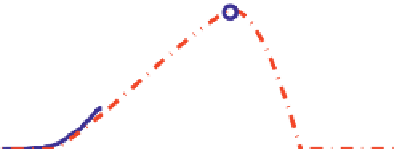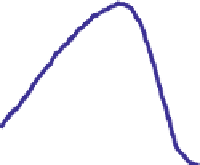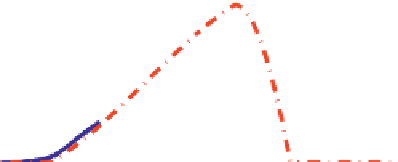Geography Reference
In-Depth Information
UT
WY
600
1000
Data
Model
Data
Model
400
500
200
0
0
S
O
N
D
J
F
M
A
M
J
J
A
S
S
O
N
D
J
F
M
A
M
J
J
A
S
MT
CO
1500
600
Data
Model
Data
Model
1000
400
500
200
0
0
S
O
N
D
J
F
M
A
M
J
J
A
S
S
O
N
D
J
F
M
A
M
J
J
A
S
WA
NM
1000
600
Data
Model
Data
Model
400
500
200
0
0
S
O
N
D
J
F
M
A
M
J
J
A
S
S
O
N
D
J
F
M
A
M
J
J
A
S
Figure 6.19. Comparison of measured (solid lines) and modelled (broken lines) time series of average snowpack storage for each day of the
year, in Utah, Wyoming, Montana, Colorado, Washington and New Mexico. Circles on measured and modelled traces indicate the peak
snow-water equivalent (SWE) and the dates near the start and end of the snow season when storage is 10% of peak SWE. Light shaded area at
left indicates modelled snowfall rate, and darker area at right indicates melt rate. Total melt equals total snowfall. After Woods (
2009
).
water excess to runoff is modelled in one case using a
lumped reservoir model (Woods,
2003
), for which at least
one parameter must be estimated.
calibrated separately on each of the gauged catchments
and then the calibrated parameters are related to the catch-
ment characteristics by regressions (see Section 10.4.4).
Both regionalisation procedures have provided satisfactory
results in Sicily in terms of mean error, root mean square
error and efficiency. The results also indicated that models
based on regional calibration appear to be robust for esti-
mating runoff in ungauged basins. In a somewhat similar
study in north-western Italy, Bartolini et al.(
2011
) com-
pared parameter regionalisation by a common regional
parameter set with separate calibration of the model to
each of the catchments, using a water balance model with
two calibration parameters. The results are consistent with
those of Cutore et al.(
2007
) in that the common parameter
set was found to be more robust than the separate calibra-
tion to each catchment. Their
6.4.2 Continuous models
While continuous runoff models are often applied at the
daily time scale (see
Chapter 10
) there are a number of
studies that directly estimate monthly runoff and the flow
regime in ungauged basins. Specifically, a number of com-
parative studies have examined the suitability of different
parameter regionalisation methods. Cutore et al.(
2007
)
compared two methods. The first involves a regional cali-
bration of a model to all the gauged basins in the region to
produce a common set of parameters. The second proced-
ure is a regression approach where the model
is first
results
(
Figure 6.20
)
















































































































































































































































































































Search WWH ::

Custom Search